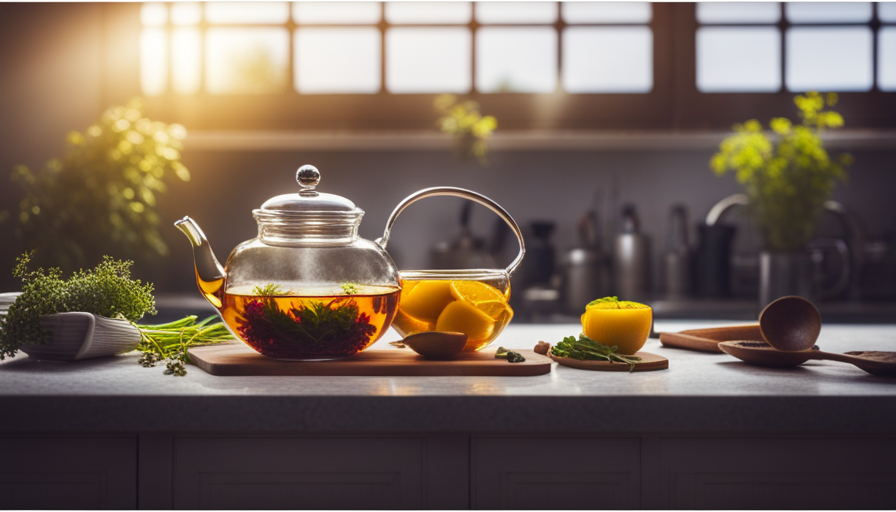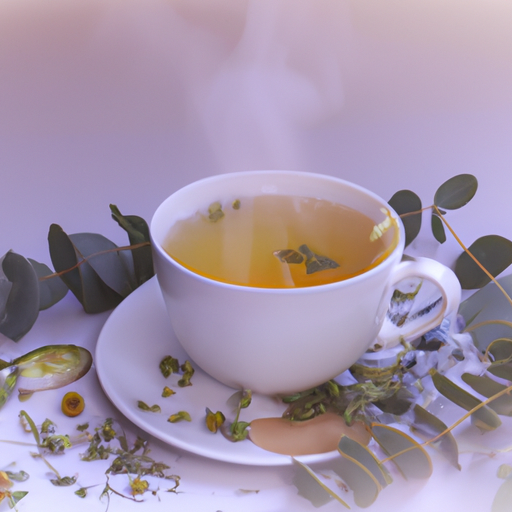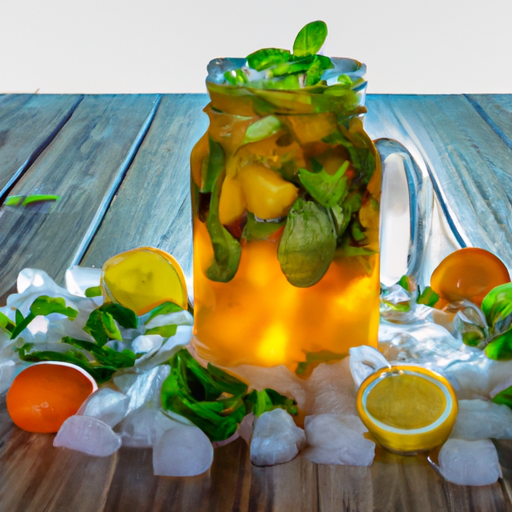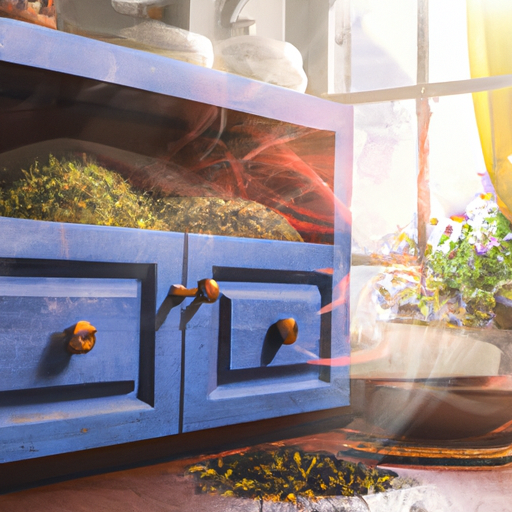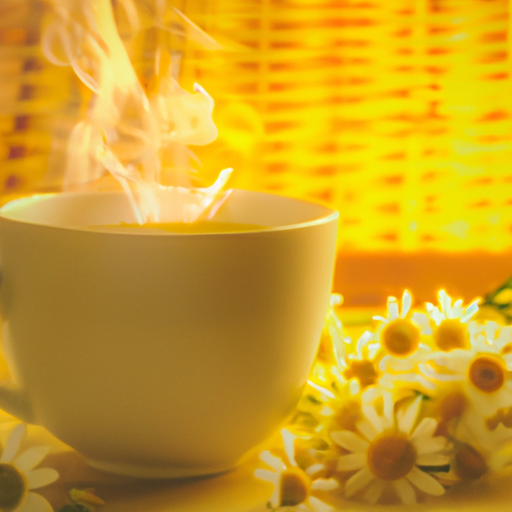Sitting in my warm kitchen, enjoying the scent of freshly brewed herbal tea, I couldn’t help but be amazed by the magic of this simple drink. Like a flower opening up, herbal tea can unveil a world of comforting tastes and healing properties. Whether you need to relax, energize, or soothe aches and pains, knowing the right way to brew herbal tea is essential to experiencing all it has to offer.
In this article, I will guide you through the art of steeping herbal tea, step by step. From understanding the different types of herbal tea to measuring the right amount of herbs and choosing the perfect water temperature, I will share my knowledge and expertise to ensure that every cup of herbal tea you brew is a sensory delight.
So, grab your favorite mug, settle in, and let’s embark on a journey of flavor and wellness. Your perfect cup of herbal tea awaits!
Key Takeaways
- Different types of herbal tea offer various health benefits.
- Water temperature is important for extracting flavors and preserving aromas.
- Steeping time allows flavors to develop fully.
- Choosing the right brewing equipment is crucial for making the perfect cup of herbal tea.
Understand the Different Types of Herbal Tea
Did you know there are various types of herbal tea that can offer a range of health benefits? When it comes to herbal tea, there are a plethora of different herbal blends to choose from. Each blend consists of a unique combination of herbs, giving it a distinct flavor and potential health benefits.
For example, chamomile tea is known for its calming properties and can help with sleep and relaxation. On the other hand, peppermint tea is great for soothing digestion and relieving stomach discomfort. If you’re looking for something to boost your immune system, echinacea tea is a popular choice.
It’s important to understand the different herbal blends so you can choose the one that aligns with your specific health needs. When it comes to steeping herbal tea, the quality of the herbs is crucial. Choose high-quality herbs that are fresh and free of any additives. By selecting the finest herbs, you can ensure that you’re getting the maximum health benefits from your cup of herbal tea.
Choose High-Quality Herbs
To experience the full flavor and scent of your brew, opt for top-notch herbs that transport you to a fragrant garden. When it comes to tea quality, selecting high-quality herbs is essential. Not only do they ensure a delightful tasting experience, but they also provide numerous herbal tea benefits.
Here are four key factors to consider when choosing your herbs:
-
Freshness: Look for herbs that are vibrant in color and have a strong aroma. Fresh herbs will infuse your tea with an intense and invigorating flavor.
-
Organic: Opt for organic herbs to avoid any traces of pesticides or chemicals. Organic herbs are grown naturally, preserving their purity and enhancing their therapeutic properties.
-
Source: Consider the source of your herbs. Look for reputable suppliers who prioritize sustainability and ethical practices. Herbs sourced from trusted growers will guarantee a higher quality product.
-
Variety: Experiment with different herbs to create unique flavor profiles. Each herb brings its own distinct taste and benefits to the brew, allowing you to customize your herbal tea to your liking.
By selecting top-quality herbs, you ensure a superior tea experience. Now, let’s move on to the next step and discover how to measure the right amount of herbs for the perfect cup of herbal tea.
Measure the Right Amount of Herbs
Ensure a harmonious blend of flavors by measuring the perfect amount of herbs, like a conductor carefully orchestrating a symphony. To achieve this, you’ll need a few essential measuring tools. A kitchen scale is ideal for precise measurements, as it allows you to weigh the herbs accurately. If you don’t have a scale, measuring spoons are a reliable alternative. Use a teaspoon for finely ground herbs and a tablespoon for larger, coarser leaves.
Remember that the intensity of flavor will vary depending on the amount of herbs used, so adjust accordingly to suit your taste preferences.
In addition to measuring tools, steeping time is crucial to extract the full flavor and benefits from your herbal tea. Different herbs require different steeping times, and it’s essential to follow the specific recommendations for each herb. Generally, herbal teas should be steeped for about 5-7 minutes. However, some delicate herbs like chamomile or peppermint may require shorter steeping times of 3-5 minutes to avoid bitterness.
Now that you’ve mastered the art of measuring the right amount of herbs and understanding steeping times, let’s move on to the next step: heating the water to the correct temperature. By carefully controlling these variables, you can ensure a perfect cup of herbal tea every time.
Heat the Water to the Correct Temperature
When preparing herbal tea, it’s important to heat the water to the correct temperature. This helps to extract the optimal flavors and beneficial properties. For robust herbs, such as mint or chamomile, boiling water is recommended as it helps to fully release their flavors. On the other hand, delicate herbs like green tea or lavender should be steeped in water that’s slightly cooler, around 175°F, to prevent bitterness and preserve their delicate aromas.
Boiling water for robust herbs
First, boil water until it’s piping hot for your robust herbal tea. When it comes to boiling water techniques for steeping herbal tea, it’s crucial to reach the correct temperature to extract the maximum flavor and benefits.
Robust herbs, such as peppermint or chamomile, require boiling water to fully release their essential oils and flavors. To achieve this, simply bring a pot of water to a rolling boil on the stove. Once the water reaches its boiling point, remove it from the heat source and let it cool for a few seconds before pouring it over your tea leaves or tea bag. By using this method, you ensure that the robust herbs infuse properly, creating a rich and flavorful cup of tea.
Moving on to lower temperatures for delicate herbs, it’s important to handle them with care to preserve their delicate flavors.
Lower temperatures for delicate herbs
To fully savor the delicate flavors of your favorite herbs, it’s time to gently coax them with lower temperatures. Delicate herbs require a more subtle approach to preserve their unique qualities and prevent bitterness. Here are five tips to help you steep delicate herbs to perfection:
- Use water that’s around 175-185°F (80-85°C) to avoid overpowering the flavors.
- Steep the herbs for a shorter duration, usually around 2-3 minutes, to prevent the infusion from becoming too strong.
- Be mindful of the quality and freshness of your herbs, as older herbs may require slightly longer steeping times.
Consider using a tea infuser or strainer to easily remove the herbs once they’ve reached the desired flavor. Experiment with different delicate herbs, such as chamomile or peppermint, to find the optimal steeping time for each variety.
By following these guidelines, you can ensure that your delicate herbs are steeped to perfection, preserving their delicate flavors and allowing you to fully enjoy their aromatic qualities. Now, let’s move on to the next step: steep for the appropriate time.
Steep for the Appropriate Time
For the perfect cup of herbal tea, let the flavors meld together as you allow it to steep for the appropriate amount of time. Steeping time is crucial in extracting the full potential of the herbs and maximizing their benefits.
The duration may vary depending on the type of herb and personal preference, so it’s important to adjust steeping time accordingly. Proper steeping allows the water to extract the desired flavors and compounds from the herbs. It allows the delicate flavors to develop fully, resulting in a more satisfying and enjoyable cup of tea.
Steeping for too short a time may leave you with a weak and underwhelming brew, while steeping for too long can lead to a bitter and overpowering taste. To determine the appropriate steeping time, consider the type of herb you are using. Delicate herbs like chamomile and lavender typically require a shorter steeping time of around 5-7 minutes. Stronger herbs like peppermint and ginger may need a longer steeping time of 7-10 minutes to fully extract their flavors.
Incorporating the right steeping time into your tea brewing routine ensures that you make the most out of your herbal tea experience. As we move on to the next section about using the right brewing equipment, keep in mind that steeping time is just one factor in achieving the perfect cup of herbal tea.
Use the Right Brewing Equipment
When it comes to brewing herbal tea, it’s crucial to use the right equipment. One key point is to choose a teapot or infuser that allows the herbs to expand fully and release their flavors.
Additionally, it’s a good idea to consider using a strainer or filter when using loose herbs to prevent any bits or debris from ending up in your cup.
By using the appropriate brewing equipment, you can ensure a delicious and enjoyable cup of herbal tea every time.
Choose a teapot or infuser that allows the herbs to expand
First off, grab a teapot or infuser that lets those herbs stretch their legs and expand to their full aromatic potential. When it comes to teapot options, there are a few things to consider. Look for a teapot with a removable infuser, as this’ll make it easier to clean and remove the herbs once they’ve steeped.
Glass teapots are also a great choice, as they allow you to see the herbs as they steep and ensure that you don’t overbrew. If you prefer using an infuser, choose one with fine mesh or tiny holes to prevent any small herb particles from escaping into your tea.
Now that you have the right brewing equipment, consider using a strainer or filter for loose herbs. This’ll help to remove any herb particles and ensure a smooth and enjoyable cup of herbal tea.
Consider using a strainer or filter for loose herbs
To fully experience the robust flavors and aromas of your loose herbs, enhance your brewing process with a strainer or filter that effortlessly captures every delicate particle.
Using a teapot for loose herbs is a popular choice, as it allows the herbs to expand freely, releasing their full potential. A teapot with a built-in strainer or infuser is especially convenient, as it eliminates the need for additional tools.
Another option is using a tea ball for loose herbs. This small, mesh ball holds the herbs securely while they steep, preventing any loose particles from floating in your tea. Tea balls come in various sizes and styles, making it easy to find one that suits your needs.
By using a strainer or filter, you can ensure a smooth and flavorful cup of herbal tea. Now, let’s move on to the next step of the process: straining and serving.
Strain and Serve
To strain and serve herbal tea, I always use a fine mesh strainer to remove the herbs from the water. This ensures a smooth and enjoyable drinking experience without any bits of herbs floating around.
Once the tea has been strained, I pour it into cups or mugs, ready to be enjoyed. It’s important to handle the hot tea with caution and serve it promptly to preserve its flavor and temperature.
Remove the herbs from the water using a strainer
Gently strain out the herbs from the water, allowing their soothing essence to embrace your senses.
To enhance your tea experience, you can experiment with alternative straining methods. Try using a fine mesh strainer to catch any small herb particles that may have escaped. Alternatively, you can use a tea ball or muslin cloth to contain the herbs while steeping.
Be mindful of common mistakes when using a strainer, such as pouring the tea too quickly, which may result in spillage or uneven distribution. Take your time and pour slowly to ensure a smooth and enjoyable tea.
Now that your herbal tea is perfectly strained, it’s time to pour it into cups or mugs, ready to be indulged in and enjoyed.
Pour the steeped herbal tea into cups or mugs
Now it’s time for you to pour that deliciously infused concoction into your favorite cups or mugs.
When serving herbal tea, there are various suggestions to enhance the experience. You can try adding a slice of lemon or a sprig of fresh mint to your cup for a refreshing twist. Another idea is to serve the herbal tea over ice for a cool and invigorating drink. If you want to get creative, consider using unique and decorative tea cups or mugs to present your herbal tea. It can add a touch of elegance or whimsy to your tea-drinking ritual.
Remember, presentation is key when it comes to enjoying herbal tea.
Now, let’s move on to the next section about adding sweeteners or enhancements (optional) to further elevate the flavors.
Add Sweeteners or Enhancements (Optional)
When it comes to enhancing the flavor of herbal tea, there are plenty of options to explore. Natural sweeteners like honey or stevia can add a touch of sweetness without overpowering the herbal notes. Additionally, experimenting with flavor additions like lemon or ginger can create a unique and refreshing twist to your cup of tea.
Explore natural sweeteners like honey or stevia
Try adding a touch of nature’s sweetness with honey or stevia, turning your herbal tea into a blissful elixir fit for the gods. Natural sweeteners not only enhance the flavor of your tea but also offer various health benefits. Honey, known for its antibacterial properties, can soothe a sore throat and boost your immune system. Stevia, on the other hand, is a calorie-free option that can help regulate blood sugar levels. To help you choose the perfect sweetener for your herbal tea, here’s a handy table:
| Sweetener | Taste Profile | Health Benefits |
|---|---|---|
| Honey | Sweet and floral | Antibacterial properties |
| Stevia | Mildly sweet | Calorie-free |
Now that you have explored natural sweeteners, it’s time to experiment with lemon, ginger, or other flavor additions to take your herbal tea to the next level.
Experiment with lemon, ginger, or other flavor additions
Enhance your herbal infusion by adding a zesty twist of lemon or a fiery kick of ginger, elevating your tea experience to new heights. Experimenting with different tea blends is a fun way to discover unique flavor combinations.
Consider trying lemon with chamomile for a refreshing and soothing blend, or ginger with peppermint for a spicy and invigorating option. These flavor additions not only enhance the taste of your herbal tea but also provide additional health benefits. Lemon is rich in vitamin C and antioxidants, while ginger aids digestion and boosts immunity.
So, go ahead and get creative with your tea infusions! In the next section, we’ll explore how to enjoy your herbal tea mindfully, savoring each sip and taking in the full sensory experience.
Enjoy Mindfully
Take a moment to savor the herbal tea and truly appreciate the mind-numbing joy it brings. Mindful tea rituals have been practiced for centuries, and for good reason. When we engage in the act of drinking tea with mindfulness, we create a space for relaxation and self-reflection. The benefits of mindful tea drinking are vast.
It allows us to slow down, be present in the moment, and connect with our senses. As we sip the warm liquid, we can feel the steam on our face, taste the subtle flavors, and inhale the soothing aroma. This practice cultivates a sense of calm and encourages a break from our busy lives.
Moreover, the art of mindful tea drinking can have positive effects on our overall well-being. It can reduce stress, improve concentration, and promote a sense of inner peace. By taking the time to truly enjoy each sip, we nourish both our body and mind.
As we transition into the subsequent section about how to store herbs properly, it is important to remember that mindfulness extends beyond the act of drinking tea. It encompasses every step of the process, from the way we choose and store our herbs to the way we prepare and enjoy our cup of tea.
So, let’s delve into the next topic and learn how to store herbs properly to ensure the highest quality brew.
Store Herbs Properly
After mindfully enjoying a cup of herbal tea, it is important to store the remaining herbs properly to preserve their freshness. Storing dried herbs in the right way ensures that they retain their flavor and potency for future use.
To maintain the freshness of your herbs, it is crucial to store them in a cool, dry, and dark place. Exposure to light, heat, and moisture can cause the herbs to lose their flavor and potency quickly. Additionally, it is essential to store them in airtight containers to prevent air from entering and causing the herbs to degrade.
To help you understand the importance of proper herb storage, here is a table that highlights the do’s and don’ts of storing dried herbs:
| Do’s | Don’ts |
|---|---|
| Store in airtight containers | Store in plastic bags or paper |
| Keep in a cool, dry, and dark place | Expose to light, heat, or moisture |
| Label containers with herb names and dates | Keep herbs near strong-smelling substances |
| Store away from strong-smelling substances | Store near the stove or microwave |
| Replace after 6-12 months | Keep herbs in the refrigerator |
By following these guidelines, you can ensure that your dried herbs remain fresh and potent, allowing you to continue enjoying the delightful flavors of herbal tea.
Frequently Asked Questions
Can I use the same brewing equipment for different types of herbal tea?
Yes, you can use the same brewing equipment for different types of herbal tea. However, it’s important to consider the different steeping times required for each tea. Some herbal teas may require longer steeping times to fully extract their flavors, while others may need shorter steeping times.
For the best herbal teas for relaxation, I recommend chamomile, lavender, and valerian root. These teas have soothing properties that can help promote a calm and peaceful state of mind.
Does the temperature of the water affect the strength of the tea?
Absolutely! The temperature of the water plays a pivotal role in determining the strength and flavor of your herbal tea.
Steeping time, on the other hand, primarily affects the flavor profile.
To achieve the perfect brew, consider the recommended brewing methods for different herbal teas.
Delicate flowers like chamomile require lower temperatures, around 190°F, while robust herbs like peppermint thrive at a higher temperature, around 212°F.
Mastering these techniques will unlock a world of exquisite flavors in your herbal tea.
How long can I store herbal tea before it goes bad?
The shelf life of herbal tea depends on various factors, including the type of herbs used and how it’s stored. Generally, herbal tea can be stored for up to 2 years if it’s stored properly. To ensure the best storage, keep your herbal tea in an airtight container away from direct sunlight and moisture. This’ll help preserve its flavor and potency. Remember to check for any signs of spoilage before consumption.
Are there any herbs that should not be used for steeping?
Some herbs can have potential side effects when used for steeping tea. It’s important to be cautious and informed about which herbs are safe to use. For example, herbs like comfrey and pennyroyal shouldn’t be used for steeping as they can be toxic.
If you’re looking for alternatives to steeping herbs for flavor extraction, you can try using herbal extracts or essential oils. These options provide concentrated flavors without the risk of potential side effects.
Can I add milk or cream to herbal tea?
Yes, you can add milk or cream to herbal tea as an alternative flavoring. However, it’s important to note that herbal teas are typically enjoyed without any additions, as they have their own distinct flavors and health benefits. Adding milk or cream can dilute the natural taste and potentially mask the herbal flavors. Additionally, milk or cream may also reduce the absorption of certain beneficial compounds found in herbal teas.
Conclusion
Well, there you have it! Now you’re a pro at steeping herbal tea. Who knew making a simple cup of tea could be so complicated? But fear not, my fellow tea enthusiasts, with these steps in mind, you’ll be able to brew the perfect cup every time.
So go forth, steep your herbs, and savor every sip. And remember, if all else fails, there’s always the trusty tea bag. Happy steeping!

